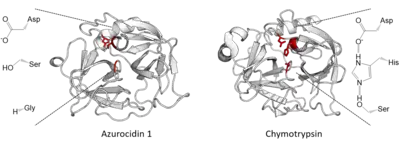
Comparison of Azurocidin 1 structure (pseudoprotease) to Chymotrypsin (functional protease) of same superfamily
Pseudoproteases are catalytically-deficient pseudoenzyme variants of proteases that are represented across the kingdoms of life.[1][2]
Examples
| Superfamily | Families containing pseudoenzymes | Examples |
|---|---|---|
| CA clan | C1, C2, C19 | Calpamodulin |
| CD clan | C14 | CFLAR |
| SC clan | S9, S33 | Neuroligin |
| SK clan | S14 | ClpR |
| SR clan | S60 | Serotransferrin domain 2 |
| ST clan | S54 | RHBDF1 |
| PA clan | S1 | Azurocidin 1 |
| PB clan | T1 | PSMB3 |
See also
References
- ↑ Fischer, Katja; Reynolds, Simone L. (2015-05-15). "Pseudoproteases: mechanisms and function". Biochemical Journal. 468 (1): 17–24. doi:10.1042/BJ20141506. ISSN 1470-8728. PMID 25940733.
- ↑ Todd AE, Orengo CA, Thornton JM (October 2002). "Sequence and structural differences between enzyme and nonenzyme homologs". Structure. 10 (10): 1435–51. doi:10.1016/s0969-2126(02)00861-4. PMID 12377129.
- ↑ Fischer, Katja; Reynolds, Simone L. (2015-05-15). "Pseudoproteases: mechanisms and function". Biochemical Journal. 468 (1): 17–24. doi:10.1042/BJ20141506. ISSN 1470-8728. PMID 25940733.
This article is issued from Wikipedia. The text is licensed under Creative Commons - Attribution - Sharealike. Additional terms may apply for the media files.